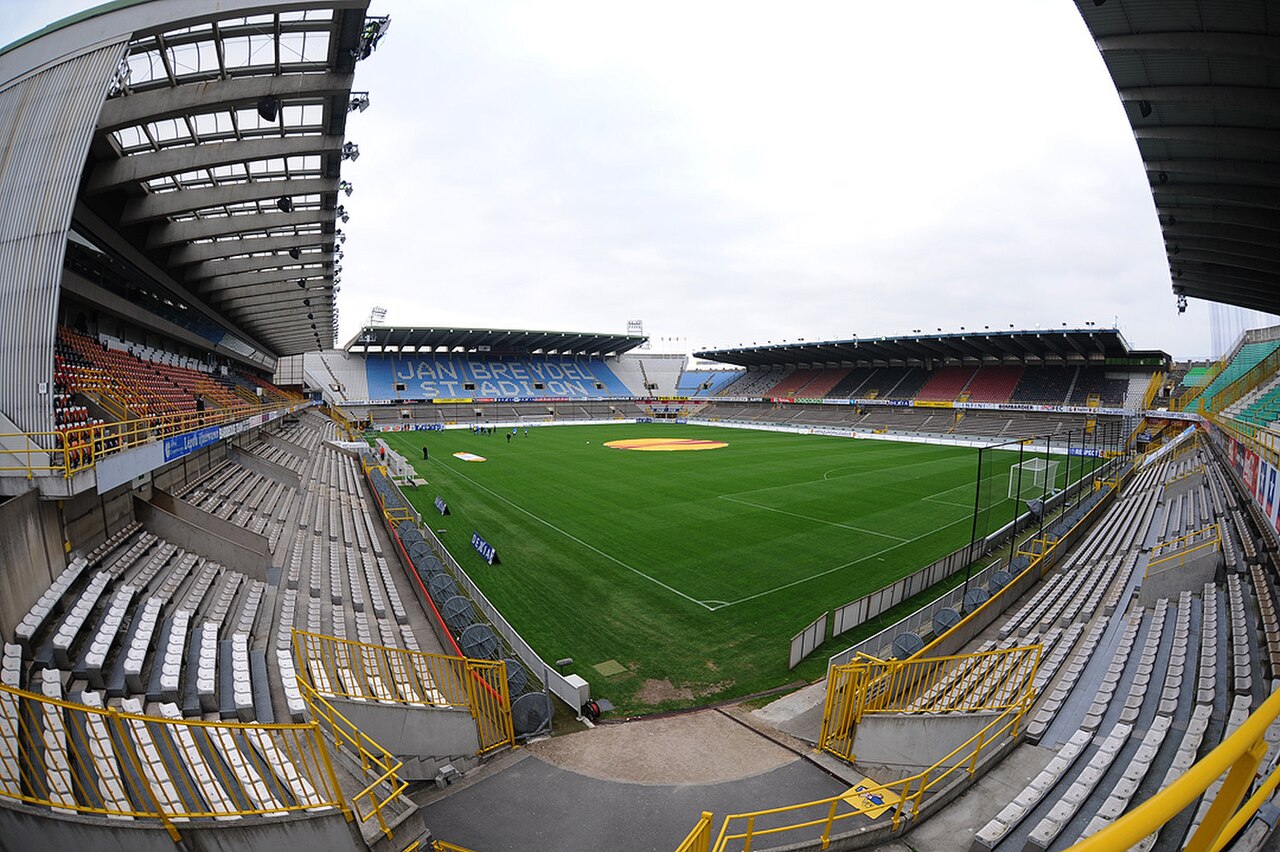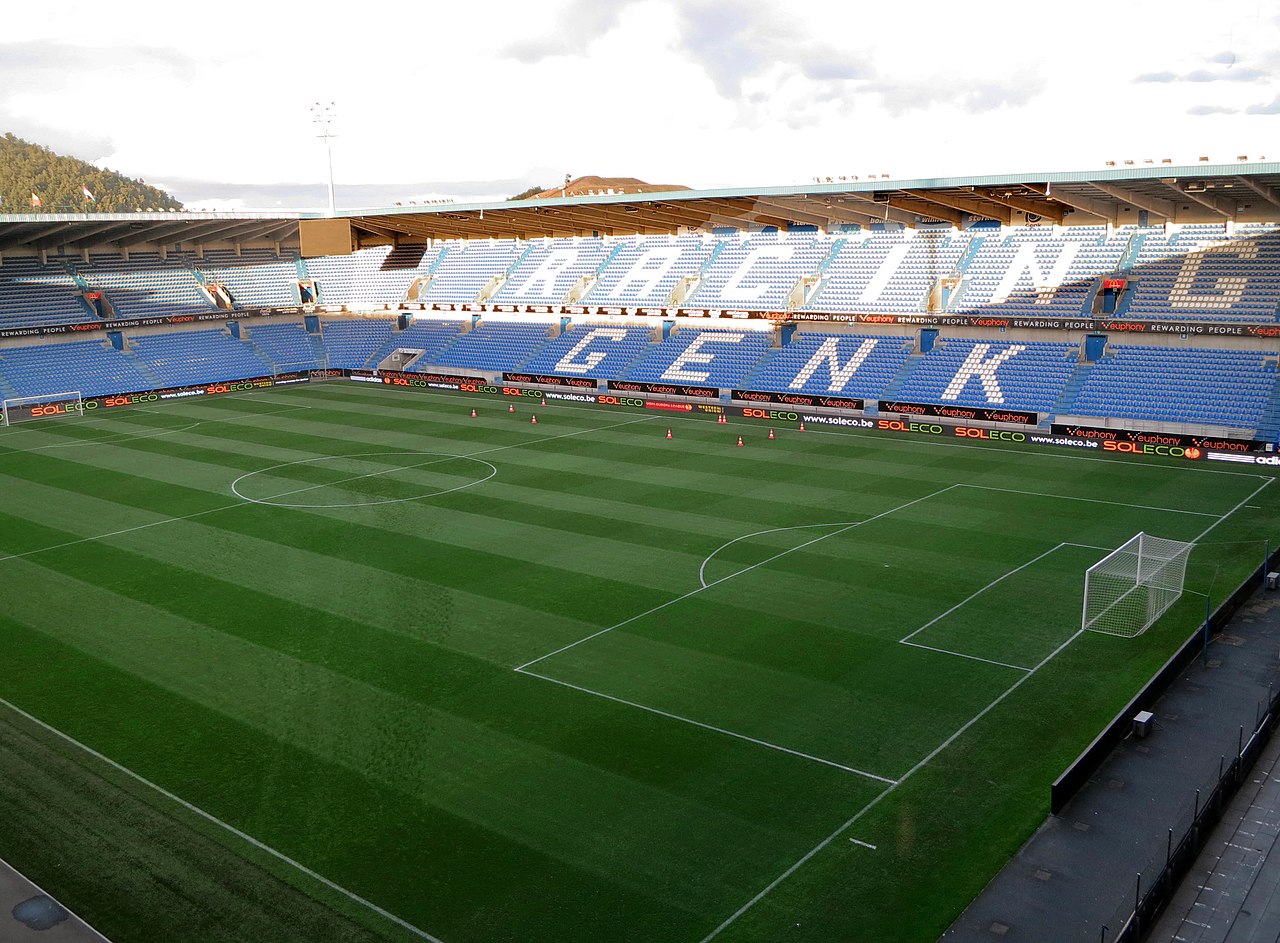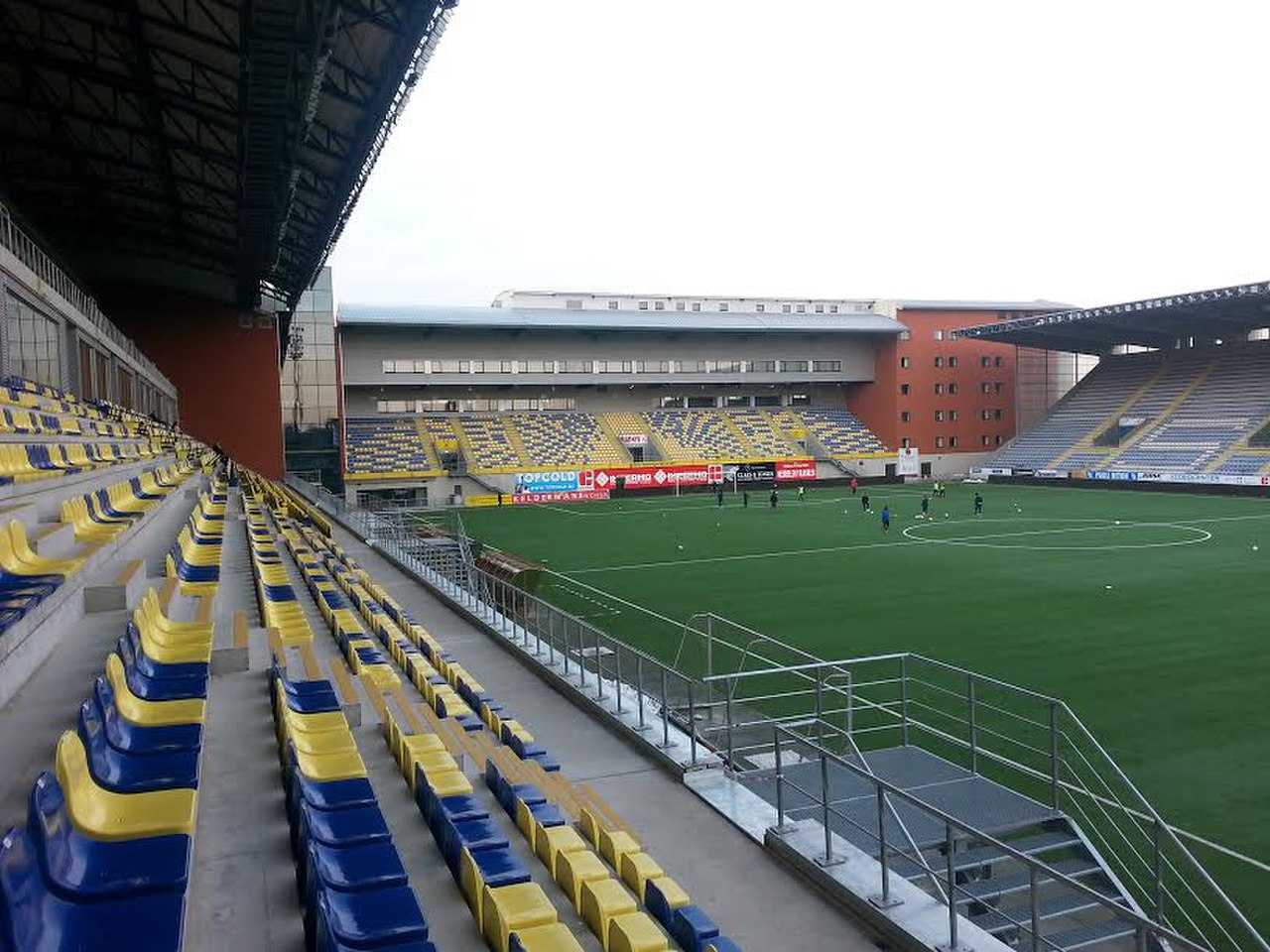Drawing from the rich tapestry of Belgium’s sporting heritage, we embark on a thrilling expedition into the world of its most awe-inspiring stadiums. Illuminating the nation’s passion for sports and its indelible mark on the cultural landscape, these magnificent arenas stand as beacons of excellence, a testament to Belgium’s unwavering devotion to athletic prowess. From the legendary Stade Roi Baudouin and Stade Maurice Dufrasne, that bear witness to countless historic moments, to the modern opulence of venues like Jan Breydelstadion and Cegeka Arena, each stadium invites us to witness the harmonious blend of sporting fervor and architectural brilliance. This captivating pilgrimage unveils a riveting tale of glory, triumph, and boundless admiration for the beautiful game, etching unforgettable memories within the hearts of spectators.
1. Stade Roi Baudouin
The majestic Stade Roi Baudouin, also known as the King Baudouin Stadium, stands proudly in the vibrant city of Brussels, Belgium, Europe. Nestled in the north-western district of the City of Brussels, this remarkable sports ground has a rich history that dates back to the 1935 Brussels International Exposition. It was during this time that the stadium was constructed to showcase the city’s grandeur and charm.
With its impressive seating capacity of 50,000, the Stade Roi Baudouin has played host to numerous thrilling football matches, attracting passionate fans from all corners of the globe. The name of the stadium pays homage to the beloved King Baudouin, who reigned as the King of the Belgians from 1951 until his peaceful passing in 1993. His influence and legacy are still felt within the stadium’s hallowed grounds.
Beyond its role as a sporting venue, the Stade Roi Baudouin holds great significance within the local community. It serves as a gathering place, bringing together people from diverse backgrounds to celebrate the beautiful game of football. The electric atmosphere and the deafening roar of the crowd create an unforgettable experience for both players and spectators alike.
Located in the captivating city of Brussels, the Stade Roi Baudouin forms an integral part of the city’s cultural fabric. It symbolizes the city’s passion for sports and acts as a shining beacon of unity for all who gather there. This iconic stadium stands tall, proudly representing the vibrant spirit of Brussels and leaving an indelible mark on the hearts of all who step foot within its gates.

2. Stade Maurice Dufrasne

Stade Maurice Dufrasne, also known as Stade de Sclessin, is a magnificent football stadium located in the vibrant city of Liège, Belgium. With its seating capacity of 30,000, it provides an electrifying atmosphere for both players and fans alike. Steeped in a rich history, this iconic stadium has witnessed countless thrilling moments of football excellence.
Situated in the charming district of Sclessin, the Stade Maurice Dufrasne holds a special place in the hearts of the local community. It has been the beloved home ground of Standard Liège since its construction in 1909, carrying the spirit and passion of the team throughout the years.
Not only has this remarkable stadium been a sanctuary for domestic football, but it has also had the honor of hosting international matches. In 1972, it proudly held one match during the prestigious Euro tournament, leaving an indelible mark on European football history. Euro 2000 further showcased its grandeur with three exhilarating matches that brought nations together in celebration of the beautiful game.
Named after the esteemed Maurice Dufrasne, former Chairman of Standard Liège, this stadium is more than just a sporting venue. Dufrasne’s legacy of nurturing talent and fostering a sense of family within the team is embedded in the very essence of this hallowed ground. His unwavering dedication is exemplified even further by his personal touch of inviting players to his home and preparing a hearty meal as a reward for their exceptional performances.
Stade Maurice Dufrasne stands tall not just as a monument to football greatness, but as a symbol of the enduring spirit and camaraderie that unites the Liège community. With its awe-inspiring presence and remarkable history, it continues to captivate and inspire all who have the privilege of stepping foot within its majestic confines.
3. Jan Breydelstadion

Jan Breydelstadion, located in Sint-Andries, Bruges, Belgium, is a vibrant multi-purpose stadium that pulsates with the energy of passionate football fans. Home to both Club Brugge and Cercle Brugge, two top-flight association football clubs, this city-owned gem is an icon of sports excellence. Steeped in history, the stadium’s name pays homage to Jan Breydel, a monumental figure in the Bruges Matins uprising that precipitated the Battle of the Golden Spurs. With a seating capacity of 29,000, every seat in this impressive arena offers a front-row experience to the thrilling action on the field. The stadium, born in 1975, has evolved over time, with its latest transformation during December 2015, when an Italian proprietary hybrid grass was laid, aptly named Mixto. Embraced passionately by the local community, this hallowed ground holds a special place in the hearts of football enthusiasts, where moments of victory and agonizing defeat are etched into the collective memory. Jan Breydelstadion, an architectural marvel and a symbol of sporting pride, stands tall as a testament to the unifying power of football in Bruges, Belgium, and Europe.
4. Cegeka Arena

The Cegeka Arena, located in Genk, Belgium, is a multi-purpose stadium that has become a symbol of passion and unity for the local community. Since its construction in 1999, this architectural masterpiece has been the roaring home ground of K.R.C. Genk, a team that is known for its relentless pursuit of victory. With a seating capacity of 23,718 (including 4,200 standing places), the stadium offers an electrifying atmosphere that brings fans to their feet, creating a wave of enthusiasm that transcends the boundaries of the game. The Cegeka Arena stands tall as a testament to the city’s love for football, attracting an average home attendance of 20,000 to 22,000 supporters every fortnight. Beyond the field, this hallowed ground holds a significant place in the hearts of the local community, serving as a hub for joy, camaraderie, and unforgettable memories. With its vibrant energy and undeniable charm, the Cegeka Arena continues to bring people together, uniting them in their shared love for the beautiful game.
5. Lotto Park
Lotto Park, also known as the Constant Vanden Stock Stadium, is an iconic football stadium located in the vibrant municipality of Anderlecht, Brussels. With its rich history dating back to its construction in 1983, Lotto Park has become a beloved landmark in the local community. The stadium, with a seating capacity of 22,000, has witnessed countless thrilling matches and unforgettable moments throughout the years. From hosting the UEFA Euro 1972 semi-final between Hungary and the Soviet Union to welcoming the Belgium national football team for various games, Lotto Park holds a special place in the hearts of football enthusiasts. Its significance extends beyond football, as it acts as a gathering place for the community, fostering a sense of unity and pride. Nestled in the heart of Brussels, Lotto Park stands as a testament to the power of sports and its ability to bring people together.
6. Ghelamco Arena
Located in Ghent, Belgium, the Ghelamco Arena (also known as Arteveldestadion) is a state-of-the-art multi-use stadium that has become a pillar of the local community. With a seating capacity of 20,000, this magnificent venue has been the proud home of football club K.A.A. Gent since its official opening on 17 July 2013. The significance of the Ghelamco Arena lies not only in its modern design and facilities but also in its role as the first newly built Belgian football stadium in almost four decades. The stadium replaced the historic Jules Ottenstadion, which had served as Gent’s home since 1920, marking a new era in the city’s sports legacy. From hosting thrilling football matches to providing a platform for community events and entertainment, the Ghelamco Arena has established itself as a symbol of unity and celebration for both residents and football enthusiasts alike. Its sleek architecture and impressive amenities make it a must-visit destination, showcasing Ghent’s passion for the beautiful game and creating an unforgettable experience for all who step inside its hallowed grounds.
7. AFAS Stadion
The AFAS Stadion, situated in Mechelen, Belgium, is a crown jewel in the world of football. With a seating capacity of 16,000, this magnificent stadium provides an electrifying atmosphere that ignites the passion of every fan lucky enough to step foot inside its gates.
Originally built in Alkmaar, Netherlands, the AFAS Stadion found its new home in Mechelen and quickly became an integral part of the local community. Its significance goes beyond being a mere sports venue as it serves as a unifying force, bringing people from all walks of life together to celebrate the beautiful game.
Nestled in the heart of Europe, this stadium represents the pinnacle of European football. Its state-of-the-art facilities and meticulously maintained playing surface create the perfect stage for athletes to showcase their skills and inspire fans with their awe-inspiring performances.
Every corner of this remarkable stadium exudes excellence, from the cutting-edge training facilities to the world-class hospitality areas. The AFAS Stadion is not just a place to watch a match; it’s an immersive experience that captivates the senses and leaves an indelible mark on all who have the privilege of attending.
With its rich history and fervent fanbase, the AFAS Stadion stands as a testament to the power of the beautiful game to bring people together. It is a symbol of unwavering determination, relentless passion, and the unbreakable bond between a community and their beloved team, AZ Alkmaar.
8. Stade du Pays de Charleroi
Stade du Pays de Charleroi, located in the vibrant city of Charleroi, Belgium, stands as a testament to the rich sporting heritage of this European nation. Originally built for the 2000 UEFA European Championship, this football stadium replaced the iconic Mambourg Stadium, marking a new era of sporting excellence. With a seating capacity of 15,000, it offers an intimate atmosphere that allows fans to feel the energy and excitement of each match.
Not only is Stade du Pays de Charleroi the home of Sporting Charleroi, but it also holds a special place in the hearts of the local community. As a hub of sporting passion and camaraderie, the stadium has witnessed countless memorable moments that have united fans from all walks of life. From thrilling victories to heartbreaking defeats, every match played within its hallowed grounds has left an indelible mark on the city’s collective memory.
Despite the future plans to relocate to a new stadium, Stade du Pays de Charleroi has embedded itself as a cherished symbol of Charleroi’s sporting identity. With its iconic roof and minor adjustments to meet European competition standards, this stadium continues to stand tall, ready to welcome fans and inspire a new generation of football enthusiasts. Whether you are a die-hard supporter or a casual observer, Stade du Pays de Charleroi is a place where the passion for the beautiful game comes alive.
9. Herman Vanderpoortenstadion
Located in Lier, Belgium, the Herman Vanderpoortenstadion is an iconic multi-use stadium that has etched its name in the hearts of football enthusiasts throughout the region. With a seating capacity of 14,538, including standing places, business seats, VIP seats, and loges, this remarkable venue sets the stage for breathtaking matches that leave fans mesmerized.
Steeped in history, the stadium has been the hallowed home ground of the revered Lierse football club since 1925. Its significance in the local community runs deep, as it has witnessed countless memorable moments and displays of unwavering dedication. This cherished stadium holds not only the echoes of victories and defeats but also the spirit of the passionate football culture that reigns supreme in Lier.
Nestled along the captivating Lispersesteenweg, the road leading to the enchanting neighborhood of Lisp, the Herman Vanderpoortenstadion is more than just a sports venue. It stands as a testament to the harmonious fusion of sports and community, where individuals from all walks of life congregate to cheer on their beloved team.
Named after Herman Vanderpoorten, a distinguished Belgian politician and former mayor of Lier, this stadium symbolizes the unity and pride that permeates the city. While uncertainty looms over the future tenants of this cherished sporting arena following the bankruptcy of Lierse in 2018, its legacy shall forever endure, intertwining the spirit of sport and the strength of community into an indomitable force.
10. Stayen

Stayen, located in Sint-Truiden, Belgium, is a football stadium that holds immense significance in the local community. With its seating capacity of 14,600, Stayen creates an electric atmosphere for the passionate fans of STVV. Originally built in 1927, the stadium has undergone several rebuilds and renovations throughout the years to become the iconic sporting landmark it is today. Its name, “Stayen”, derived from the local dialect word for “Staden”, pays homage to the historical quarter of the town on its western side. The stadium’s history is rich with memorable moments and fierce battles between top teams, earning it the revered nickname, “Hell of Stayen”. Furthermore, the stadium’s unique feature is the Stayen Hotel, ingeniously built into the north side, offering 20 rooms with stunning views overlooking the pitch. Stayen continues to etch its legacy, as it proudly bears the name “Daio Wasabi Stayen Stadium” from February 2023 onwards, thanks to the groundbreaking partnership of a Belgian league first with a Japanese company acquiring the naming rights. Stayen represents not only a football arena but a cultural hub that unites the local community in their shared love for the beautiful game.
11. Daknamstadion
Located in the charming village of Daknam, in the heart of the picturesque municipality of Lokeren, Daknamstadion stands as a symbol of passion, resilience, and sporting excellence. This football stadium has a rich history and holds an important place in the hearts of the local community. Originally the home ground of Sporting Lokeren, the stadium now serves as the proud home of Lokeren-Temse, showcasing the unbreakable spirit of this football-loving town.
With its impressive seating capacity of 12,000, this stadium is a true marvel. From the moment you step foot inside, you can’t help but be captivated by the electric atmosphere and the undeniable allure of the game. Whether you’re a die-hard football fan or simply an admirer of world-class sporting arenas, Daknamstadion is sure to leave you awe-inspired.
The significance of Daknamstadion extends far beyond its capacity to entertain and unite sports enthusiasts. It is an integral part of the local community, a source of pride, and a symbol of togetherness. Its presence in Daknam serves as a meeting point for friends and families, a place where lifelong memories are forged, and dreams are realized.
In 2014, the stadium underwent a transformation, expanding its capacity to its current impressive level. While the reduction in capacity in the 1980s was a necessary step for security reasons, it was not enough to dampen the indomitable spirit of the fans. Daknamstadion rose from the challenges it faced, emerging stronger and more vibrant than ever.
Daknamstadion is more than just a football stadium. It is a testament to the unwavering determination and resilience of a community. It is a symbol of the power of sport to bring people together and evoke emotions that transcend the boundaries of language and culture. Join us at Daknamstadion and experience the magic for yourself as you become part of a legacy that will stand the test of time.
In essence:
In the enchanting realm of Belgian football, our pilgrimage through the mesmerizing stadiums nears its end. These hallowed grounds, adorned with architectural marvels, have not only witnessed gripping matches but have become an indelible part of the nation’s essence. As we bask in the kaleidoscope of moments, the heartbeat of the fans, and the dramatic stories etched into the very walls, it’s evident that each stadium reverberates with its own tale. From the majestic Stade Roi Baudouin to the captivating Stade Maurice Dufrasne, and the vibrant Jan Breydelstadion to the modern Cegeka Arena, the spirit of competition binds us all. As our final whistle echoes across the breathtaking Lotto Park, Ghelamco Arena, AFAS Stadion, Stade du Pays de Charleroi, Herman Vanderpoortenstadion, Stayen, and Daknamstadion, let the enduring legacy of unity, passion, and the beautiful game inspire generations to come.
Ready to dive into the world of sports diversity? If you enjoyed the blog, click here to explore iconic stadiums from South Africa, Vietnam, Belgium.